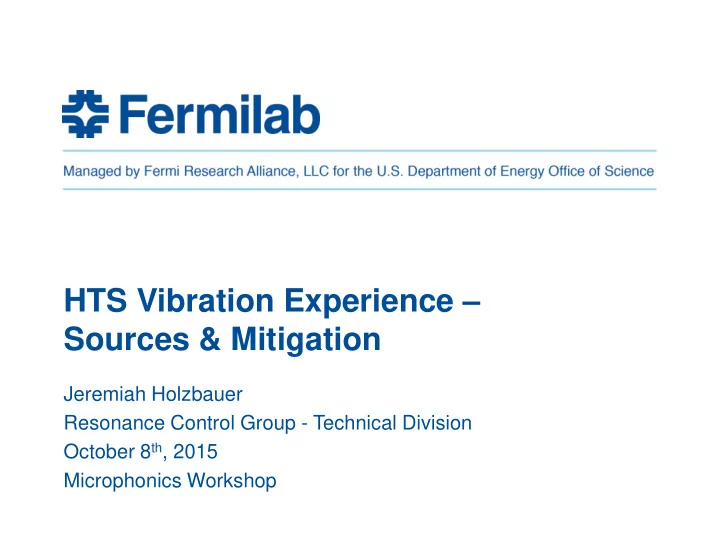

HTS Vibration Experience – Sources & Mitigation Jeremiah Holzbauer Resonance Control Group - Technical Division October 8 th , 2015 Microphonics Workshop
Synopsis • Resonance Control Group has conducted several rounds of testing at HTS and discovered a quite sizable amount of microphonics disturbance – Notable sidebands at 30, 50 Hz and harmonics • Larry D. and Brian C. attempted to control the cavity but were unable to because the detuning was so large • Early attempts at diagnosis and mitigation revealed some obvious sources, and the environment was improved to the point testing was reasonable • Further studies have proved relatively fruitful (Warren’s Presentation) • The results of this study and the resulting mitigation proposals will be presented here 2 J. Holzbauer | HTS Vibration Experience 10/7/2015
Testing Setup • Measuring voltage driven across the cavity piezoelectric tuners gives a measurement of the cavity mechanical vibration • Because the cavity it warm, it cannot easily be correlated with absolute frequency detuning, but the spectral information is still quite useful for diagnosis of vibrational sources • A pair of geophones was used in the cave at large to measure surface vibrations • Data was taken for 1 second periods, and the spectral powers were averaged over a number of data sets, usually close to 10 • Caveat: 120 Hz line is almost certainly electrical noise 3 J. Holzbauer | HTS Vibration Experience 10/7/2015
Cold HTS Transfer Function Data 4 J. Holzbauer | HTS Vibration Experience 10/7/2015
Measurements of cavity vibration (microphonics) using (1) RF signal from cavity & (2) piezo signal/piezo as a sensor Cavity as SENSOR Piezo as a SENSOR 10/7/2015 J. Holzbauer | HTS Vibration Experience 5 Credit to Yuriy for the Slide
Insulating Pump Stack 6 J. Holzbauer | HTS Vibration Experience 10/7/2015
AD Cryo Box Fans • Two box fans on a plate to mitigate valve heat leak, large vibration source • Initially hard mounted, now soft mounted through grommets • Heat leak is too large to have them off for more than a couple hours without significant icing • AD cryo should be able to modify/replace with a non-vibrational heat source 7 J. Holzbauer | HTS Vibration Experience 10/7/2015
AD Cryo Box Fans – Geophones Next to Source Cavity Resonances? *Again, be wary of 120 Hz peak/harmonics 8 J. Holzbauer | HTS Vibration Experience 10/7/2015
AD Cryo Box Fans – Piezo Data 9 J. Holzbauer | HTS Vibration Experience 10/7/2015
Geophones on Tuner Bracket 10 J. Holzbauer | HTS Vibration Experience 10/7/2015
AD Cryo Box Fans – Geophone Data 11 J. Holzbauer | HTS Vibration Experience 10/7/2015
ODH Blowers/HVAC Duct • Ventilation in the HTS cave is run by two systems in parallel • HVAC is (theoretically) controlled by a thermostat outside the cave • ODH ventilation blowers run 24/7 when the cave is unsecured • ODH blowers should be off when cave is secured • Primary vent blows directly onto a cryo relief stack which hard-connects to the HTS stack 12 J. Holzbauer | HTS Vibration Experience 10/7/2015
Cryo Relief Stack 13 J. Holzbauer | HTS Vibration Experience 10/7/2015
HVAC/ODH Blower is a large noise source 14 J. Holzbauer | HTS Vibration Experience 10/7/2015
Probe Spectrum Noise ON vs. OFF 15 J. Holzbauer | HTS Vibration Experience 10/7/2015
Mitigation Conclusions • ODH blower, HVAC, and AD cryo box fans seem to be the dominant sources of noise • All spectral lines between 50 and 55 Hz (the dominant sources) seem to be suppressed or removed by these changes • The ODH should no longer be a problem as it should shut off when the cave is interlocked (the original intention, and now restored) • The HVAC can be turned off for periods of time when needed (summer is harder) • The AD cryo box fans were just turned off, and the Cryo guys keep an eye on the valve icing 16 J. Holzbauer | HTS Vibration Experience 10/7/2015
Future Work - Conclusions • Passive mitigation is only one aspect of microphonics stability – Cavity/Tuner Design (excellent work done on df/dP for SSR1) – Cryogenics/Cryomodule Design (bath pressure environment, mechanical modes) • My motto: “Passive mitigation first, last, and always.” • Good news: Vibration sources/issues are often obvious in retrospect • Bad news: That retrospect part • A centralized effort must be made to think about these issues ahead of time (my opinion) 17 J. Holzbauer | HTS Vibration Experience 10/7/2015
Changes to FEA thermal shield model Results from previous FEA Material properties of thermal shield: EN AW-1050A, Al 99.5% G10 support rods (newly added in 3D model), The extruded tube material: EB AW-6060 AlMgSi0.5 two on each end of lower shield To restrict the motion, in case of seismic event Table I. Mass Distribution of Finite Element Model (kg) the lower shield cannot move further due to cold mass the G10 rods getting in contact with the inside cavity string 509.93 of the vacuum vessel shield 2061.5 Plan to leave a gap between the inside of the Expected to be lower vacuum vessel and the tip of these G10 rods, for thermal leak & shrinkage Table II. Density and Modulus of model parts Part density modulus (kg/m^3) (GPa) shield 13815 207 18 J. Holzbauer | HTS Vibration Experience 10/7/2015 Credit to Yun He for the Slide
Recommend
More recommend